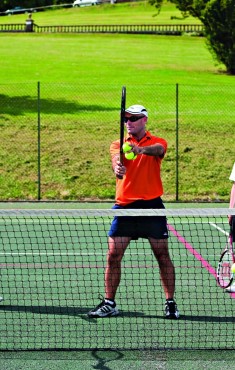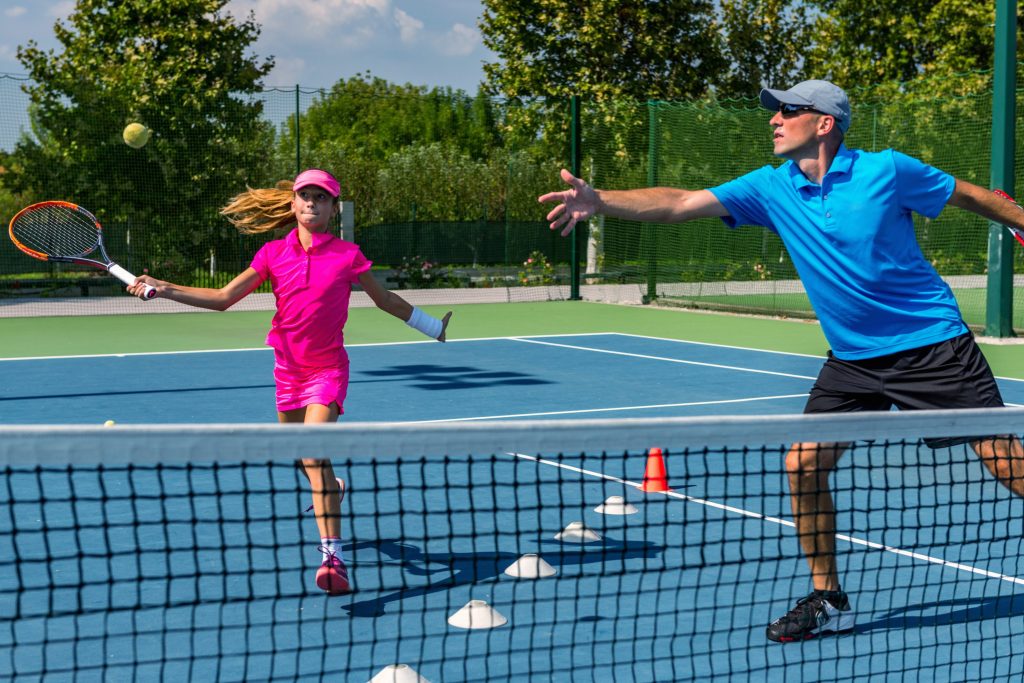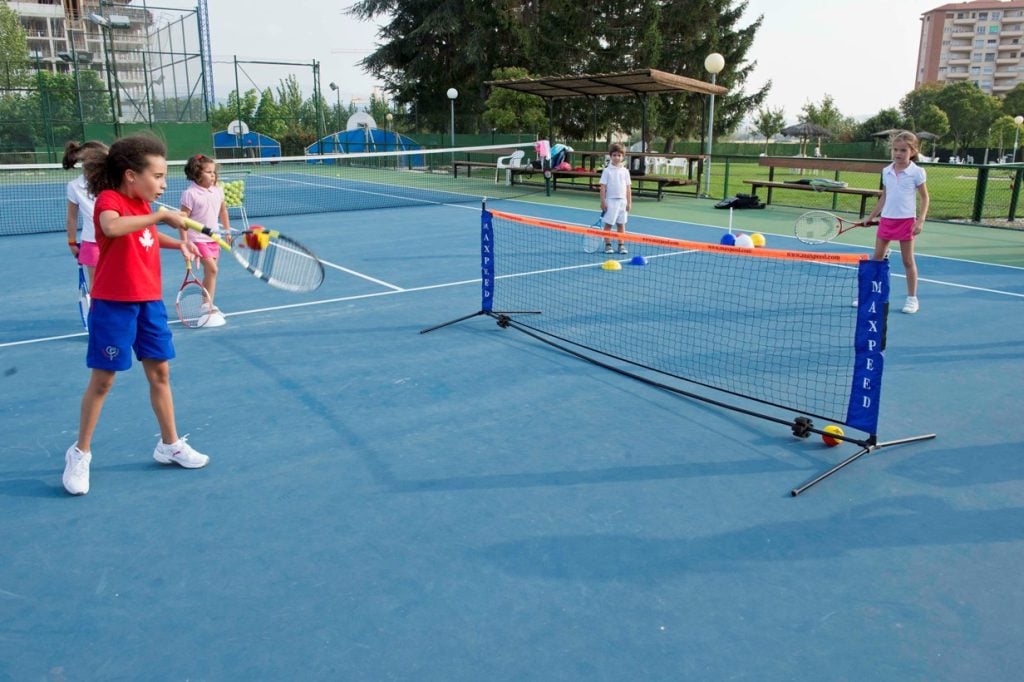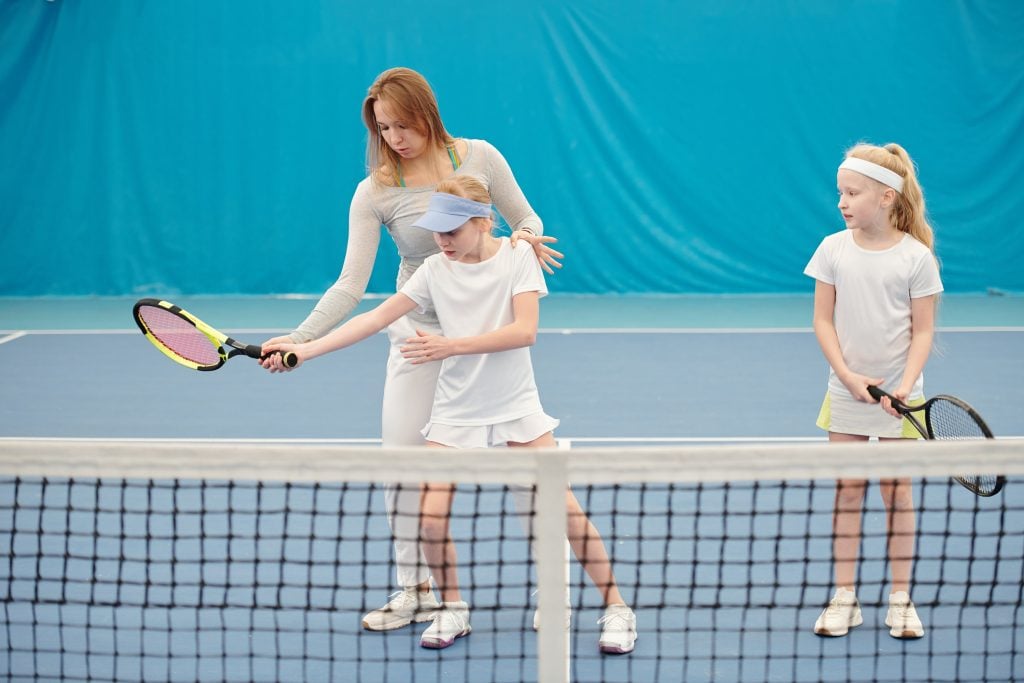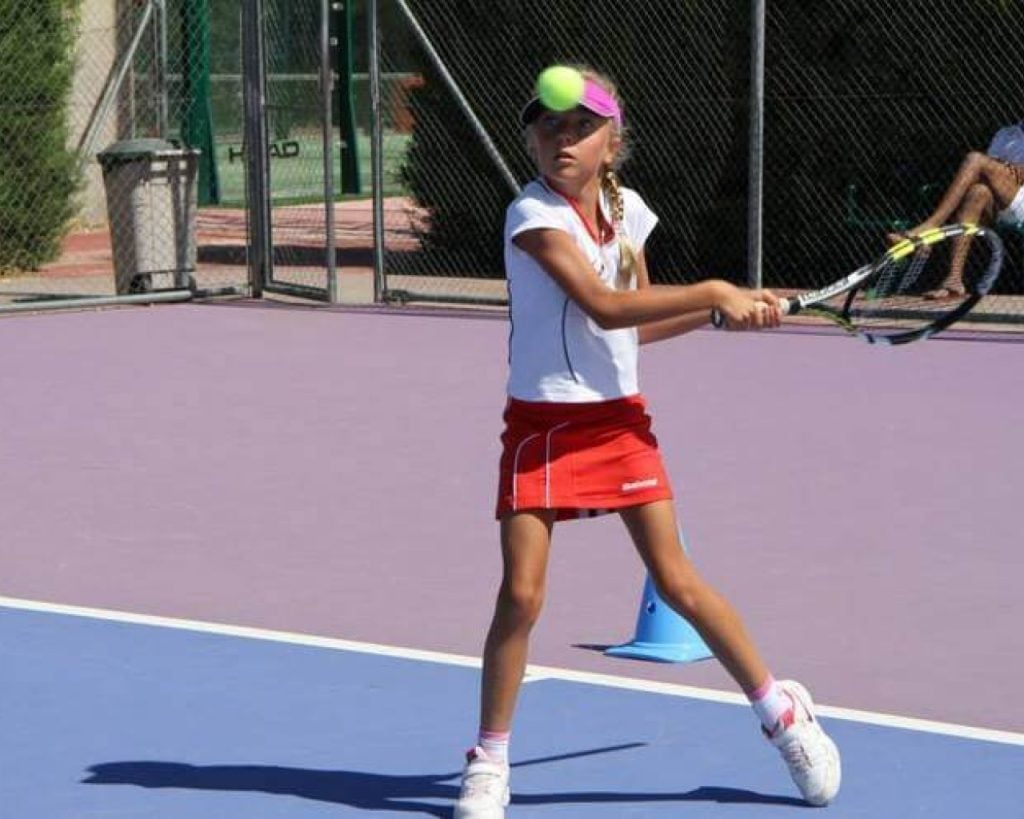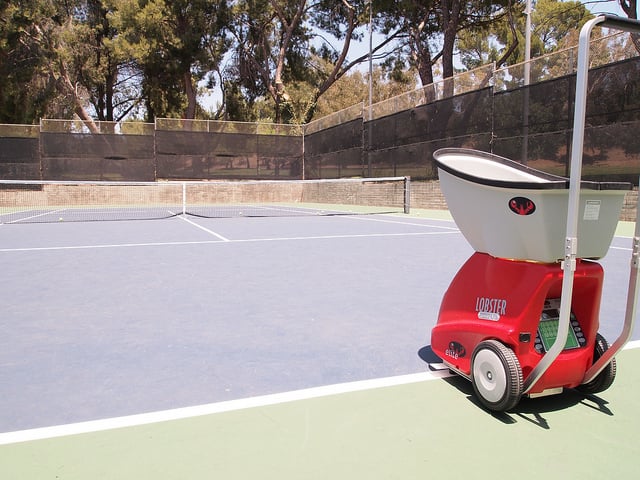Table of Contents
To excel on the court, it is not enough to know how to hit the ball. Mastering tennis strokes involves understanding when and how to execute them according to the surface, the opponent and your style of play.
Tennis is a strategic sport, where each stroke has a purpose. Some are more offensive, others defensive, and the key is knowing how to choose the right one at each moment.
But don’t worry, constant practice makes the difference. At Ertheo we offer tennis summer camps for all levels, where players perfect their technique and understand the importance of each stroke.
At first, some strokes will seem easier than others, but with training and repetition, you will improve your accuracy, power and control. Below, we review the essential tennis strokes for any player.
Waiting position: the basis of every stroke
Before learning any stroke, you must master the waiting position. This initial position allows you to react quickly and move with agility on the court.
The waiting position consists of keeping your back straight, leaning your hips slightly forward and bending your knees. The weight of the body should rest on the tips of the toes, which facilitates the start of the movement.
The most important aspect of this posture is to get out of it quickly. A tennis player is never static, so training this position will give you the stamina you need to stay active throughout the match.
Once you have mastered the waiting position, it is time to start practicing the most important types of tennis strokes.
Forehand or drive: the base of the attack
The forehand, or drive, is one of the most commonly used strokes in tennis. It is the main attacking weapon of many players and, fortunately, one of the easiest to learn.
To execute it correctly, you must wait for the ball after the bounce and profile sideways, with your skilled arm ready to hit it.
The stroke itself is a bottom-up motion, designed to lift the ball up and over the net with power and spin if necessary.
But it’s not just the arm that matters. The feet play a key role in the power of the stroke. The weight should rest first on the weak leg, while the strong leg accompanies the arm movement to give it strength.
At the end of the stroke, the weak foot remains as support, while the strong foot follows the inertia of the movement of the torso and shoulders.
when to use a forehand strike?
The ideal point of impact is at chest height, as it allows for a more powerful stroke.
If the ball comes higher, you can take advantage of it to give it more power, especially if you are a tall player. On the other hand, if the ball arrives at hip height, adding topspin is the best option to give depth and placement to the shot.
It is also important to consider the surface. On hard court or grass, the drive is key to find winning shots. On clay, its use is more strategic, allowing to vary the speed and spin to make the opponent uncomfortable.
By the way, when a forehand allows you to go to the net with an advantage, it becomes an approach, a fundamental offensive resource to finish points with a volley.
We leave you this video with more tips on how to hit an effective forehand/drive:
Backhand: The weapon you cannot neglect
The backhand is the stroke that complements the drive and can be just as lethal if you master it well. However, it is one of the most difficult to perfect.
one-handed or two-handed backhand?
There are two ways to hit it: one-handed or two-handed.
Today, most coaches recommend the two-handed backhand, as it provides more stability, power and control. Players such as Jannik Sinner and Carlos Alcaraz have perfected this stroke, making it one of their most dangerous weapons.
The one-handed backhand, although less common, is still effective for players who prefer more reach and variety of spin, such as Stefanos Tsitsipas or Stan Wawrinka.
The choice depends on the player’s style and comfort in execution.
Executing a solid backhand
Unlike the drive, the backhand requires you to profile your body to your weak side and hit the ball while it is still forward in your stance.
Footwork is crucial: the strong leg must hold the support, while the less skilled leg helps to give fluidity to the motion.
The secret is to coordinate grip, feet, torso and swing in one fluid motion. It is a stroke that requires patience and constant practice.
How to use the backhand according to surface and opponent
If your opponent has a weak backhand, take advantage of it to always play to that side and force him to defend.
On clay, the backhand opens a world of possibilities. You can combine it with drop shots to wear your opponent down or with a slice to break his rhythm.
On hard court and grass, the parallel backhand is one of the most effective weapons, as it allows you to catch your opponent off guard, either flat, topspin or slice. Each version has its use, and mastering them will give you more options to build your game.
Serve or serve: The start of every point
The serve is the most decisive stroke in tennis. A good serve gives you an advantage in every point and can make you a difficult player to break.
Holding your serve and making it very difficult to break you will make you a solid and fearsome player, so it is a shot that you must practice a lot.
Executing an effective serve
To begin, stand behind the baseline with the less skilled foot in front and the skilled foot aligned parallel to the baseline.
The grip should be firm, and the ball is thrown with the non-dominant hand as the racquet arm prepares to impact at the highest point.
The serve is divided into three types: flat, topspin and slice. Each has its function and can be used strategically depending on the opponent and the surface.
Modern trends in the serve
In recent years, players have changed the way they use their serve. In the past, the first serve was always a bid for power, while the second serve was more conservative.
Today, many players are opting for a more aggressive second serve, with kick or slice, to prevent the opponent from taking the initiative.
The kick serve has become a key tool on clay, as it makes the ball bounce high and more difficult to attack.
Players like Novak Djokovic and Daniil Medvedev have shown that a well-placed serve, rather than just a powerful one, can make the difference on any surface.
How to gain an advantage on serve
The serve is not just about power, it’s about strategy. It is not about hitting the same place every time, but about playing with the expectations of the opponent. A good serve should be unpredictable, allowing you to take the initiative on every point.
- The first serve should be powerful and placed to displace the opponent. A good serve down the line or an ace will give you an immediate advantage.
- The second serve should be more confident, with spin to prevent the opponent from attacking easily. A well executed kick can make the ball bounce high and make the return uncomfortable.
- Vary the direction of your serve: if you always serve to the same place, your opponent will adapt and respond more accurately.
If you master your serve well, you will have an advantage from the beginning of the point. A well-executed serve can make the difference between pressure and total control of the game.
Here is the video on how to serve in tennis:
Volley: Dominating the net
The volley is the ideal stroke for those who want to play offensively close to the net. It is executed before the ball hits the ground, allowing you to take control of the point and close out plays quickly.
For an effective volley, place the opposite foot to the impact side in front and hit with a short, controlled motion. It is not necessary to make a big swing, as the goal is to redirect the speed of the ball accurately.
Volleys can be either forehand or backhand, so it is important to practice them on both sides of the court.
when to use the volley?
Volleys are usually the finishing touch to a well-constructed attack, so they should be executed after a shot that allows you to go up with an advantage. In this sense, a well-placed approach will make it easier for you to close the point at the net.
Mastery of the volley has been one of the keys to the most successful players in the history of tennis. Roger Federer perfected this stroke and combined it with his serve to close points quickly.
Today, players like Carlos Alcaraz have revived the net game, using aggressive volleys to surprise their opponents on any surface.If you are a good serve and have a good stature, never neglect your volley. It can become a lethal weapon to put pressure on your opponent and shorten points.
Smash or Smash: The ultimate shot
The smash is the most forceful blow to finish a point when the opponent leaves a floating ball.
It is executed over the player’s head, with a movement similar to the serve, but with a more aggressive impact.
To perform a powerful smash, it is key that the elbow of the dominant arm passes behind the head before the execution.
The combination of knee bend and forward motion ensures a solid and accurate hit.
when to use a smash?
This stroke should be used when the ball is coming high and slow, allowing the player to position himself correctly to execute it.
On hard courts, it is advisable to hit the smash towards the ground to take advantage of the quick bounce. On clay or grass, it is more effective to direct it towards the opposite side of the opponent, as the ball loses speed on these surfaces. A good trick is to deceive the opponent with the direction of the smash, especially if he/she is a player with great defensive capabilities.
Dejada or Dropshot: Subtlety to surprise
The drop shot is one of the most strategic strokes in tennis. It is based on touching the ball gently so that it falls close to the net, making it difficult for the opponent to arrive in time.
A well executed dropshot can completely change the dynamics of a point, forcing the opponent to go all the way across the court to return it.
when to drop shot?
The key is to make it when the opponent is far from the net, waiting for a powerful shot.
The best players “hide” the drop shot until the last moment, making it look like they are going to hit a strong shot and, at the last moment, softening the impact.
This stroke is especially effective on clay, where the ball bounces less and it is more difficult to move quickly forward.
Carlos Alcaraz is one of the best current exponents of the dropshot, using it to displace his opponents and create space on the court.
However, it must be executed with precision. A poorly executed dropshot will leave the opponent with an easy ball to finish off.
The counterpunch: The best answer
If the opponent manages to get to a drop shot, your best option is usually a counterpunch.
This stroke is performed on the run and very close to the net, looking to return the ball with the same subtlety and placement.
If you can execute a good counterpunch, you can completely dislodge your opponent and take control of the point.
Globo: The stroke to change the rhythm
The lob is one of the most effective tools to get rid of an opponent who is constantly attacking at the net.
Its objective is to send the ball over the opponent, forcing him to retreat or leaving him with no possibility of response.
To execute it correctly, the impact must be from the bottom up, achieving a high and well placed arc.
when to throw a balloon?
The lob is ideal when the opponent goes up to the net after an approach. If you hit it with the right height and depth, you will force your opponent to back up and hit in an awkward position.
If the lob is effective, you can use the advantage to go up to the net and close the point with a volley.
This stroke is equally useful on all surfaces, but is particularly effective on clay, where players tend to move with greater distance from the baseline.
Beware of short lobs. If the ball is left halfway, the opponent will have the perfect opportunity to execute a smash.
how to choose the best tennis racquet?
Knowing which racket to choose is as important as mastering tennis strokes.
The racquet influences the power, control and spin you can put on the ball, so finding the right one will make all the difference in your game.
Before buying one, you should consider your experience level and playing style:
- Beginners: Need a racquet with a large sweet spot and more power to make hitting easier.
- Intermediates: Looking for a balance between power and control, with a more stable frame and better feel at impact.
- Advanced: They prefer more technical racquets, which allow greater control and precision in each stroke.
Other important factors include weight, balance and string pattern. A lighter racquet facilitates maneuverability, while a heavier racquet offers stability on powerful shots.
If in doubt, it is best to try different options or seek professional advice. With the right racquet and constant practice, you will take your game to the next level.
Conclusion: The key is practice and strategy
As you can see, tennis is a sport that combines technique, tactics and mentality. Mastering strokes requires not only skill, but also patience and consistency.
Each stroke has its ideal moment, and knowing when and how to execute them is what distinguishes the best players.
Beyond talent, what really makes the difference is dedication to training. Practicing with the right guidance will help you develop a solid foundation and perfect every aspect of your game.
If you want to improve your level and train with professionals, Ertheo’s tennis camps are the perfect opportunity. With programs designed for all levels, you’ll learn from expert coaches while enjoying a unique on-court experience.
ready to take your tennis to the next level? Find out more about our camps and start your path to improvement.

